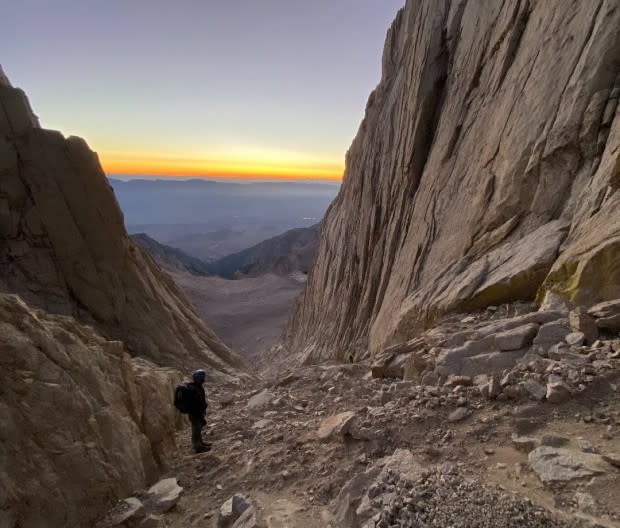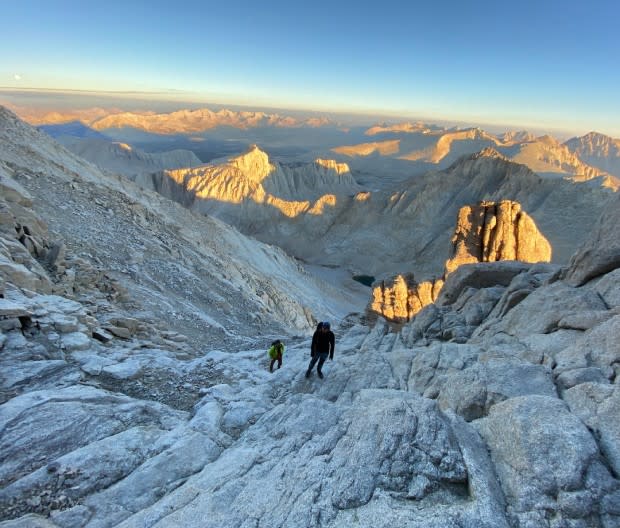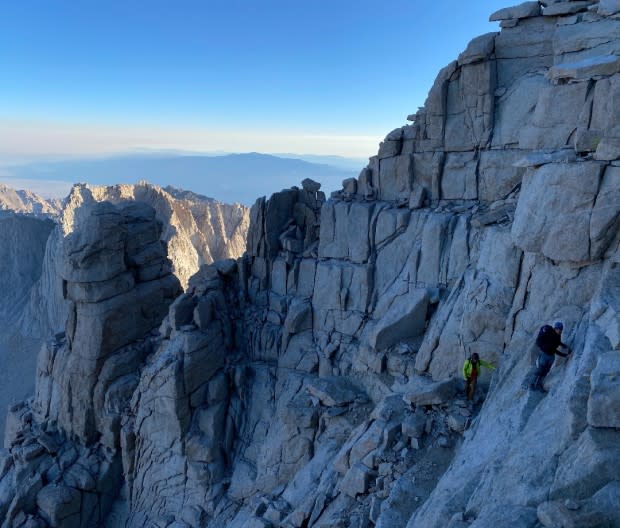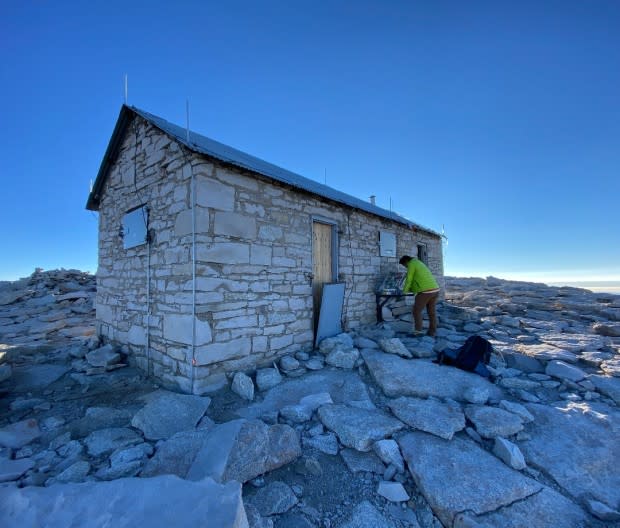How to Scale Mighty Mount Whitney in Under 24 Hours
I left the Whitney Portal Trailhead right at midnight, the sheer granite gorge brightening under another starry night in California's spectacular High Sierra. Elevation at the trailhead is just under 8,400 feet, and the summit of famed Mount Whitney, the tallest mountain in the Lower 48, looms at 14,505 feet. It was going to be a good, long day tackling the peak, which gets our vote for one of the best summits to push for climbers of all levels. But hiking Mount Whitney in under 24 hours is a big day to say the least.
You'll climb just over 6,000 feet of elevation at challenging altitudes in a single day. Most hikers and climbers take two to three days to do it, camping along the way before reaching its lofty, scenic perch overlooking the gritty Alabama Hills, the stark Owens Valley, and the daunting Inyo Mountains to the east.
Related: Best Climbing Destinations for Beginners: Learn How to Climb
Typically, those hiking Mount Whitney choose an out-and-back approach, flipping between two routes: the Mount Whitney Trail or the North Fork of Lone Pine Creek (aka the Mountaineer's Route). Whichever route is chosen, all peak baggers have their own methods and tricks of the trade to reach the summit of Mount Whitney. Here’s a quick primer on this legendary peak and the 10 essentials to consider before heading up to sign your name in the ledger at the summit hut.
Where Is Mount Whitney and How to Get There
Mount Whitney is located in California’s Eastern Sierra. From Highway 395 at the closest town of Lone Pine, take the Whitney Portal Road about 12 miles west to the trailhead. On clear days, hikers and climbers can easily view Mount Whitney from Highway 395. Driving through the stunning Alabama Hills and its massive granite clusters—the site of hundreds of movies and commercials—Mount Whitney and the Eastern Sierra make for a dramatic backdrop. The paved road winds its way into the mountains, passing several campgrounds before reaching the trailhead. For last-minute items, from sunscreen and lip balm to hats and other supplies before your ascent, visit the Mount Whitney store—which also makes a great burger.
Mount Whitney’s Claim to Fame
Hiking Mount Whitney is a huge feat, because it's the highest summit in the U.S. outside of Alaska. Beyond its most obvious claim to fame, there’s no denying the rugged beauty of this standout mountain in the heart of the Eastern Sierra—a range filled with superb-looking peaks whether you’re climbing them or gazing from afar. Of the 15 peaks in California that are over 14,000 feet, Mount Whitney is the most sought after, drawing the largest crowds during peak climbing season.
Related: Best Climbing Destinations for Beginners: Learn How to Climb
Best Time to Visit Mount Whitney
The best time for hiking Mount Whitney is late summer into early fall when monsoon season is in the rearview mirror and weather conditions are milder. Fall is a magical time in the Eastern Sierra. The sun sits lower on the horizon, serving up sunrises and sunsets of spectacular pink and orange hues at this time. Climbing Mount Whitney in the colder months is an entirely different deal, requiring solid winter mountaineering skills.
What to Do in and Around Mount Whitney (Besides Climbing to the Top)
Even if you’re not beelining for higher altitudes, the rugged foothills below Mount Whitney are a playground for hikers, climbers, paddlers, and recreationists of all kinds. The nearby Alabama Hills are a popular rock-climbing destination, and the Lower Owens River offers fantastic paddling possibilities with the Eastern Sierra as a majestic backdrop. Aside from hiking Mount Whitney, climbers can add on a pair of 14,000-foot peaks flanking Whitney's sheer granite eastern face—with Mount Langley to the south and Mount Russell to the north, both of which are very attainable. Also adjacent to the Whitney summit is the epic North Ridge of Lone Pine Peak.

Chuck Graham
10 Essentials for Climbing Mount Whitney
1. Understand the Permit Process
You’ll have to enter the lottery for a Mount Whitney permit on recreation.gov, which opens in February. In March, lottery winners are notified, and by April those winners must pay for their permit. If you don’t win a permit, don’t despair. There are still two other ways to snag one.
The first method is by grabbing someone’s canceled permit online—which requires hovering at recreation.gov and hoping a permit winner who can’t use theirs cancels on the site. This obviously requires its own share of luck and impeccable timing. Method two is by scoring a “No Show” permit. This requires showing up in person at either the Inyo Visitor Center in Lone Pine or the Wilderness Permit Office in Bishop and waiting for a scheduled climber to not print out their permit off recreation.gov by noon on the day before the scheduled ascent—in which case you can obtain their permit. Eventually, this will happen but possibly not the first day you show up, so you’ll need to have some flexibility. You’ll also have to pay for the permit online. Office staff will then print your permit to be carried with you during your ascent.
Related: 7 Most Scenic Mountain Golf Courses in North America
2. Begin by Acclimating
Whitney summit hopefuls should be well-acclimated to High Sierra altitudes before their single-day ascent. The best way to do this is to tack on at least a day before your climb to do a shorter hike or two to help your body adapt to the environment. A great acclimation day hike along the Mount Whitney Trail is from the Whitney Portal Trailhead up to beautiful Lone Pine Lake—a 2.8-mile climb to the shimmering, mirror-like pool perched at 9,850 feet. Once there, have lunch, rest, relax, and enjoy acclimatization at its finest.
3. Gear Down
Lighter is better—especially on Mount Whitney. You don’t need a heavy pack to reach this summit, but there are some items needed to complete a one-day ascent. Dress in layers and don’t skimp on the essentials—including a headlamp, rain gear, sunglasses, sunscreen, hat, gloves, trekking poles, an adequate water supply, and an open mind.

Chuck Graham
4. Figure Out Which Route Is Best for You
Most folks head up the Mount Whitney Trail, a well-maintained, 22-mile, out-and-back, walk-up route. The less crowded route is the North Fork of Lone Pine Creek—aka the Mountaineer's Route—which is under half the distance, but that much steeper, more technical and physically demanding than the latter with some route-finding involved. The views are arguably better on the latter route, with a stupendous view of the east face and east buttress of Mount Whitney.
Related: How to See Rainbow Mountains of Peru Minus the Crowds
5. Start Early and Hike at Night
Whatever route you take, hiking in the middle of the night ups your chances of ascending (and don’t forget descending) Whitney in a single day. Plus it’s cooler, the darkness takes your mind off how far you have to go, and your focus and concentration is aimed on the immediate terrain. Then there’s the real payoff at the top. There’s nothing like sunrise on the highest peak in California and the whole Lower 48. You’re also less likely to endure monsoonal flow at night. Throughout the summer especially, these storms typically unleash their fury in the afternoon.
6. Hydrate
Just as you should be acclimated before hitting the trail, you should be well-hydrated when you start the climb—and equipped with a sufficient supply of water (about 3 liters works for most climbers) without overloading yourself. Water is heavy and there are plenty of creeks and alpine lakes to resupply along both routes up to about 12,000 feet. Don’t forget to drink water as you climb. Carrying it won’t do you any good if your body isn’t consuming it. Throughout the day, I drink a bottle of water and rest, then refill and continue upward.

Chuck Graham
7. Fuel Up
Being acclimated and hydrated are essential, but you must also eat all day. You may not feel like it, especially at higher altitudes, but those calories are important to successfully summit. I like dried mangos, dates, burritos, nuts, and Probars. I also like gels like Cliff Shots and Honey Stingers to suck on throughout the day. That arid mountain air can dry the mouth out, so I pop chews throughout the day as well.
8. Prepare for Weather
Keep your eye on the weather a week out before hiking Mount Whitney. I rely on windy.com, which covers wind, clouds, snow, rain, fog, and other weather factors that are definitely good to know before you go. In spite of all preparation, weather in the Sierras can be unpredictable at any time, so be prepared for any and all conditions to crop up (often swiftly) during your climb.

Chuck Graham
9. Pack It in, Pack It Out—and Mind the Critters
Wildlife is abundant on Mount Whitney, which is part of Inyo National Forest. Creatures great and small, from black bears to golden-mantled squirrels, call these slopes home—and it’s our responsibility to keep wilderness areas cleaner than how we found them. That means packing in and packing out. Marmots can pose a particular threat above the treeline. I once saw a backpacker filtering water along the Mount Whitney Trail, completely unaware of the marmot that took the opportunity to tug his unattended pack (which he’d left just off trail) into a deep hole in the granite while the owner’s back was turned. Don’t turn your back on your pack. You might not see it again.
10. Don’t Underestimate the Descent
Reaching the summit is only half the battle. There’s relief and euphoria while standing on any summit, but descending can be just as challenging. Fatigue, hydration, temperature, and other factors can be especially insidious on the way down. Just because you reached the summit, don’t underestimate part two of this journey—easier and swifter as it may seem. Keep drinking water, fueling up on more calories, and take frequent breaks even if you don’t think you need them. All of those factors on Whitney play their hand until you’ve returned to the trailhead.
